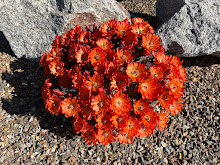I'm sure that my garden is host to many plans that others would say no to. But it works the other way too. Here are two plants I absolutely say no to.
The first is the Green milkweed vine, Matelea reticulata. "Oh, what a little beauty." I hear many say.
How could you not fall in love with such a sweet little flower with those attractive net-like veined petals and that single perfect pearl at its center. So adorable. And how often do you come across a green flower?
This plant showed up in my English garden a few years ago. Before I knew it it had taken a stranglehold on my Philippine Violet. My efforts to remove it have proved worthless and it appears every year. And yet I never hear anyone say anything bad about it. Just watch where you let it grow.
The plant appears in my Texas Wildflower book where it is described as having a hardy and robust nature and with the suggestion to place it where the leaves will not be disturbed because they have an obnoxious odor. I photographed this one on my neighbors wrought-iron fence, behind our septic field, where I can admire its beauty.
Being a member of the milkweed family it is generally thought that it is host to the Monarch butterfly caterpillar, but they are still waiting for evidence to support this theory.
As to my second 'no' say hello to the Asiatic dayflower, Commelina communis. There are probably a few heads nodding in agreement but even some who like this plant. It is actually a deeper blue than this photo shows. The flowers appear in the morning and close up by lunch time-and that's enough for it to make hundreds of seeds.
When it appeared in my garden a few years ago I was, at first, delighted. Then, when I noted its aggressive behavior I changed my mind. It's a devil to get rid of. Rather like nut sedge it has a rather bulbous root which is untouched by weedkillers.
If you don't get the whole root out it will be back again tomorrow. Furthermore if you leave a nodule behind a new plant will spring up. It is an annual but produces thousands of seeds and like most 'weeds' many will lie dormant in the soil.
So this years war is on the dayflower. Last year it was with the nut sedge. That one is not over yet although I have it kerbed(curbed) its growth for now. It will be back I am sure.
Monday, June 6, 2016
Subscribe to:
Post Comments (Atom)































8 comments:
There are so many plants out there that should never be allowed. The lady who owned our home before us took any and all "freebie" plants.....most of them aggressive spreaders. I've had a devil of a time removing these things. It's a constant battle. Now, when I'm offered plants, I do a search on them to see if they will become future problems. "just say no" is good advice when in doubt.
I had never heard of the Matelea reticulata, but I have definitely seen Commelina communis being weedy in a few gardens around the neighborhood.
I absolutely agree about the blue dayflower. I thought it was pretty at first too. Now it is EVERYWHERE and hard to pull up, just breaks off. The other monster in my garden is a pink nicotiana. I hate that plant.
Ugh. Those dayflower roots look monstrous. At least it's not a perennial to boot! 😲
Why is it, some plants we really don't want, have such pretty flowers? Maybe, it's a ruse, to make us let them stay.
Keep fighting the thugs, and best wishes for success. A wise warning to always research a plant before allowing it in the garden.
I bet the deer don't eat either one....
That milkweed is very pretty - but they don't call them milk'weeds' for nothing, I guess! I just found one of those Asiatic dayflowers growing in my garden behind a shrub a couple weeks ago. I had to look up what it was and found out they are invasive here. (Thanks for the reminder that I still need to pull it!)
Post a Comment